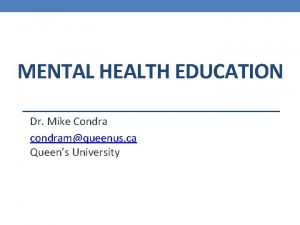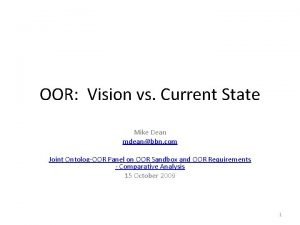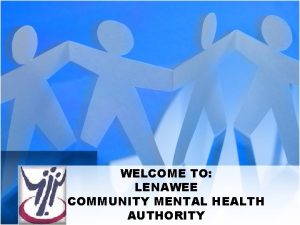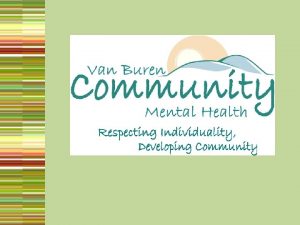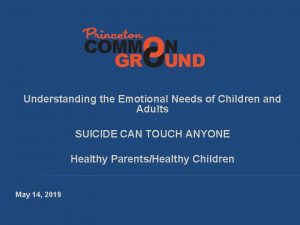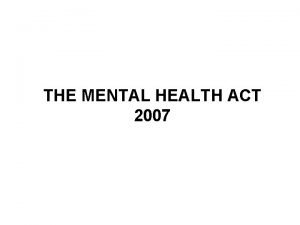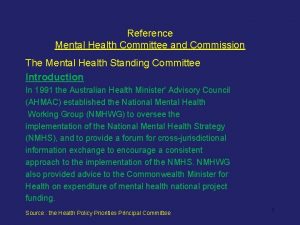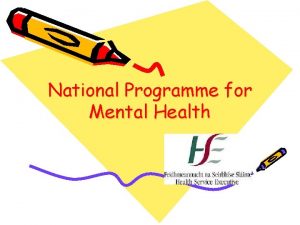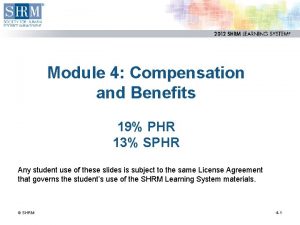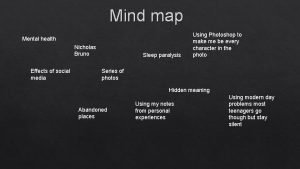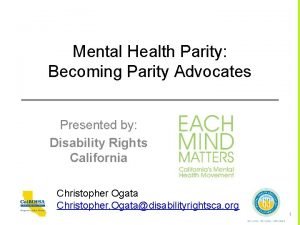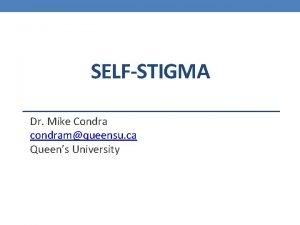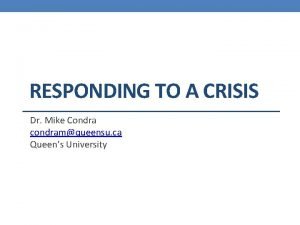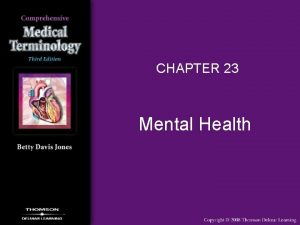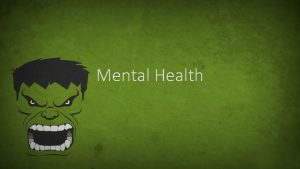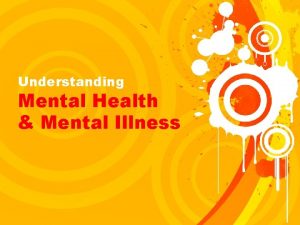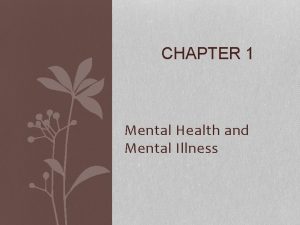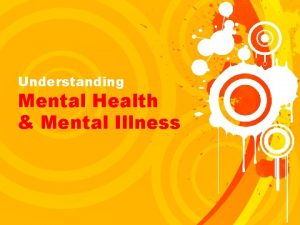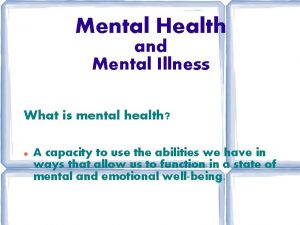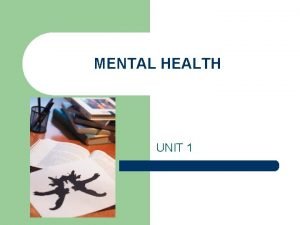MENTAL HEALTH EDUCATION Dr Mike Condra condramqueenus ca


























- Slides: 26

MENTAL HEALTH EDUCATION Dr. Mike Condra condram@queenus. ca Queen’s University

Agenda 1. Mental Health Continuum Review + Activity 2. How You Can Support a Person with a Mental Health Problem 3. Signs of Common Mental Health Problems

What is Mental Health? A state of successful performance of mental functions, resulting in: • Productive and/or meaningful activities • Fulfilling relationships • Ability to adapt, change, and cope with adversity WE ARE CONTENT AND WECAN DEAL WITH STRESSES

Mental Health Continuum Healthy Mild Disruption Moderate Disruption Severe Disruption

Mental Health Continuum • People experience mental health problems differently • People can move along the continuum • There is overlap between zones

Review: Case Scenarios In your small group, review the handout (“Case Scenarios”) and look at the continuum. Discuss the following questions with your group: • Identify where the individual is on the mental health continuum. • Explain the rationale for your choice. • What could you do to help this individual?

Card Sorting Activity • Cards will be distributed that have terms printed on them that are often used to describe a person’s mental health. • Place your card where you think it belongs on the continuum between healthy and severe disruption. • Be prepared to explain the rationale for your placement.

A Quick Re-Cap of Mental Health Problems 1. Mood Disorders 2. Anxiety Disorders 3. Disordered Eating and Eating Disorders 4. Suicidal Ideation 5. Substance-Related Disorders

Depressive Disorders – Signs and Symptoms Thinking Emotions Sadness Mood Swings Hopelessness Anxiety Self-Criticism Thoughts of Suicide Indecisiveness Pessimism Loss of Hope Behaviour Crying Spells Withdrawal Neglect of Personal Appearance Lack of Motivation Physical Lack of Energy Sleeping Too Much/Little Weight Loss/Gain

Signs of Suicidal Ideation • Sense of lack of control • Loss of hope • Lack of sense of a viable future Three “I”s • Psychological pain that is • Inescapable • Interminable • Intolerable

Bipolar Disorders – Signs and Symptoms Manic/Hypomanic Symptoms Depressive Symptoms Dramatically Increased Energy Elevated Mood Reduced Need for Sleep Irritability Rapid Thinking and Speech Lack of Inhibitions Lack of Insight

Anxiety Disorders – Signs and Symptoms Emotions Thinking Physical Nervous Powerless Sense of Impending Doom Difficulty Concentrating Unwanted Recurrent Thoughts Heart Rate Tiredness Sweating Trembling Rapid Breathing Behaviour Repetitive Behaviours

Disordered Eating and Eating Disorders Anorexia Bulimia Binge Eating

Eating Disorders – Signs and Symptoms Behaviour Skipping meals Excuses for not eating Eating only “safe” foods Rigid diet Not wanting to eat in public Eating large amounts of high fat or sweet foods • Use of over-the-counter weight loss pills or laxatives • Leaving meals to go to the bathroom • Eating in secret • • • Thoughts • Distorted body image • Low self-esteem Emotions • Intense fear of becoming fat or of weight gain • Feeling of being out-of-control • Depression Physical Signs • • Wearing baggy clothes Excessive exercise Thin or overweight appearance Difficulty sleeping (too much/little)

Substance-Related Disorders Types of Substances • Alcohol • Prescription Drugs • Over the Counter Drugs/Substances • (solvents, glues or aerosols) • Illegal Drugs Signs of a Substance Use Problem • Increasing frequency and/or amount • Increased reliance on substance to cope with new situations • Memory lapses • Increased socializing with people who use • Lying about use • Difficulty to meeting role expectations/obligations • Financial problems • Increased risky behaviours

Adapting Your Approach • What are three things a Peer Mentor could do to adapt their mentoring approach when working with a student who appears or shows: • Low mood, low energy (“I’m so tired. I don’t think I can do it. Why bother? I’m a failure. ”) • Visibly anxious, difficulty concentrating (“I’m so stressed I can’t think clearly. ”) • Low self-esteem, highly self-critical (“It has to be perfect or I can’t hand it in. ”) Remember: Goal is not diagnosis, but rather being mindful of your own mentoring approach (YOUR behaviour, words, energy level, body language)

How You Can Help ALSR Approach Listen Support Refer

ALSR • Attentively • Non. Judgementally • Reach out; Talk to them when you are calm and have time Approach • Give reassurance and comfort. Give advice only when asked. Support Listen Refer • Help them find resources and encourage use.

Techniques • Say what you see – focus on behaviour • Avoid assumptions, using labels or offering a “diagnosis” • Try to talk to the person at a good time in a quiet and private environment Examples • “I’ve noticed that you have missed some of our appointments and I’m concerned” • “You don’t seem like yourself lately. How are you doing? ” Approach • “You seem down. Are you feeling OK? ”

Techniques • Active listening; summarizing and clarifying statements • Provide the opportunity for the person to vent; only speak when the person is finished • Don’t offer personal judgements about what the person is feeling • Minimize distractions • Be present Examples • “Is there anything I can do to help? ” • “It sounds like you’re feeling. . (reflect listening, paraphrase Mentee)” Listen • “That sounds difficult to deal with”

Techniques • Offer hope and affirm the likelihood that things will get better • Show that you are there and want to help • Offer perspective; Offer empathy not sympathy Examples: • “I am glad that you’ve told me this” • “Although you are feeling this way now, it doesn’t mean that you will feel this way forever. ” • “Things can get better” • “You are not alone” Support

Techniques • Point out that help is available and affirm selfdisclosure and help-seeking as signs of strength/courage • Make a plan; offer to stay with the person while they contact the resource and to follow-up if needed • If the person refuses the referral, respect their decision; you cannot force a person to get help unless it is an emergency situation Examples • “Have you thought about talking to someone about this? ” • “I know of some good resources” • “Help is available” Refer

Applying the ALSR model – Case #1 You have been meeting with your Mentee for 8 weeks. Tracey typically arrives on time and actively contributes to the meetings, which have largely focused on exploring positive coping techniques for exam and testing anxiety. She has been late for the past two meetings, and seems visibly anxious about her upcoming midterm. Discussion: 1. Where is Tracey on the Mental Health Continuum? 2. How would you apply the ALSR model? 3. How would you adapt your mentoring approach based on the signs or cues you notice in Tracey?

Applying the ALSR model - Case #2 During the last 2 weeks you have noticed some marked changes in Danika’s behaviour and appearance. She seems very tired and quite withdrawn. She answers many of your questions with oneword responses; this is a marked change from her typical behaviour. She also seems to be much less engaged and responsive to your suggestions. She has also not been following through with her homework commitments. At today’s meeting, Danika becomes visibly upset and tearful for no apparent reason. Discussion: 1. Where is Danika on the Mental Health Continuum? 2. How would you apply the ALSR model? 3. How would you adapt your mentoring approach based on the signs or cues you notice in Danika?

Recap and Questions • Mental health is on a continuum, and we can range from a healthy zone to a severe disruption • Supporting someone with a mental health disorder involves a four-step process: Approach, Listen, Support, Refer Questions?

One Thing I Learned
 Mike condra
Mike condra Mental health and mental illness chapter 20
Mental health and mental illness chapter 20 Mental health jeopardy questions and answers
Mental health jeopardy questions and answers Causes of mental retardation slideshare
Causes of mental retardation slideshare Difference between health education and physical education
Difference between health education and physical education Difference between health education and propaganda
Difference between health education and propaganda Mike dean education
Mike dean education Peninsula
Peninsula Lenawee county cmh
Lenawee county cmh Van buren county cmh
Van buren county cmh Chapter 3 achieving mental and emotional health answer key
Chapter 3 achieving mental and emotional health answer key Together for mental health
Together for mental health Mental health act 2007 summary
Mental health act 2007 summary Health triangle
Health triangle Titles for mental health presentation
Titles for mental health presentation Health committee introduction
Health committee introduction Wellness in mind nottingham
Wellness in mind nottingham Mental health nursing define
Mental health nursing define 3 part nursing diagnosis examples
3 part nursing diagnosis examples Mental health programme
Mental health programme National mental health programme objectives
National mental health programme objectives Mental health equity
Mental health equity Photoshop mind map
Photoshop mind map Middle tennessee mental health institute
Middle tennessee mental health institute Mental health safety talk
Mental health safety talk Golden thread clinical documentation
Golden thread clinical documentation Mental health equity
Mental health equity
